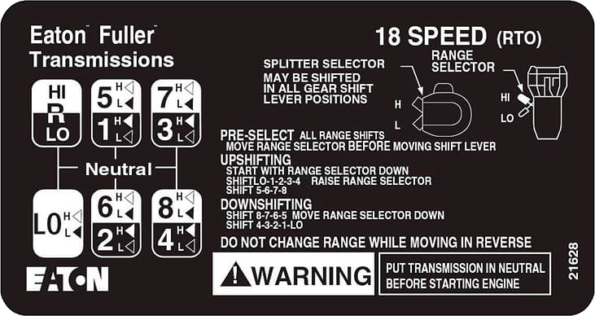A Roadranger gearbox is a non-synchro manual gearbox used in many American and Asian trucks. We covered how to change gear using a Roadranger previously, and for detailed operation and techniques from professional drivers and driver trainers you can learn how to drive a Roadranger in this online course.
Roadrangers (sometimes written Road Rangers) take some practice to get used to and there are many tips for driving them and getting the best performance.

Starting off
Set the parking brake before starting the vehicle and ensure that the shift lever is in neutral.
Make sure that the clutch is fully down to enable the clutch brake so that you can get it in gear while you’re stationary. Don’t use the clutch brake when shifting – you’ll only push the clutch down around halfway when shifting.
If you have a button on the side of the gearstick, this is the countershaft brake. Push in the clutch, press the control button and shift into gear. Don’t use this while upshifting or downshifting, only use it for initial gear engagement.
Choose a gear where you do not need to apply any throttle to move away – the torque of the engine should enable you to start. If you’re stalling it, you’re in too high a gear. If you’re feathering the clutch to get it moving, you’re in too high a gear.
Floating gears
Eaton (the maker of the gearbox) recommends you don’t ‘float’ gears. Floating the gears is when you change without using the clutch. While it’s possible to do this, if you don’t get it right, you’re causing the gearbox cogs to wear against one another and this prematurely wears out the gearbox. It can also damage the selector forks.
Reversing
Keep reversing at a slow speed when reversing with a trailer. Use lo range when reversing with a trailer. When reversing without a trailer, if it’s safe to go faster, you can use hi range. Eaton recommends you don’t use the splitter when in reverse.
Never go from lo to hi range or vice versa while in reverse as it can break or loosen the pins on the synchroniser hub.
Changing gears
Always double clutch, don’t float the gears, as we mentioned above. If your shifts are rough, then you’re probably pushing the clutch too far in and it’s activating the clutch brake. Move your seat further back if this happens.
Don’t slam the gear into the gate. If it’s not going in then you’ve either not matched the revs, or the gear lever is in the wrong position.
Pre-select the range shift when moving from lo to hi or hi to lo – don’t do this in neutral.
Don’t downshift at too high a speed otherwise you’ll over-rev the engine. A good rule of thumb is to come down to at least 1000rpm before you shift down a gear.
Don’t ride the clutch, i.e. don’t rest your foot on the clutch. Even a small amount of pressure can start to separate the clutch plates which will cause them to spin against one another.
Don’t move the gear shifter into LO when you are in high range.
Avoid shock-loading the transmission. This can happen if you wheelspin and then the tyres suddenly grip, or if you hit a loading dock.
Gear positions 1-4 vs 5-8
Once you’re rolling, you’re unlikely to use gears 1-4 much unless you are hauling heavy loads (e.g. a road train), driving off-road or driving on steep hills. You’ll use 5-8 much more frequently. Gear 5 is your go-to gear – you’ll almost always be able to get it into gear 5 however badly you mess up the change.
5th gear is the best gear to be in for negotiating intersections and it’s the first ratio where you’ll start to pick up some reasonable speed.
